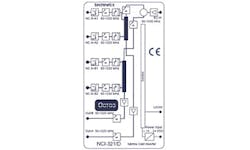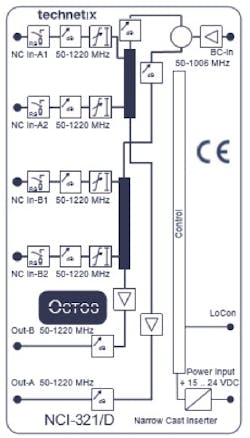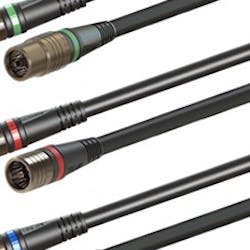Many MSOs are increasingly migrating to CCAP in a staged approach, taking it one signal source at a time, resulting in less services to combine in the headend.
Technetix’ NCI solution grows with changing requirements and has added a new module to its NCI portfolio.
The NCI platform is a 19” 3RU active signal combining solution. It consists out of the 19” chassis, which has an integrated 22-way broadcast splitter. The broadcast signal is inserted through the narrow cast controller NCC-2222. The controller also acts as an RF amplifier covering the splitter loss of the 22-way split on the back plane.
The NCI-321/D is a 1.2GHz double 2-way narrowcast inserter for the next generation of CCAP equipment. The new NCI-321/D module (compared to its predecessor NCI-521-12) has only two narrowcast inputs per section, but has two sections, meaning two outputs. When slowly migrating services to CCAP, MSOs require fewer narrow-cast input ports. This double-density unit grows with the MSOs doubling the density in headends. With a fully populated NCI rack that comes with 23 slots (one of which is dedicated to the system controller), you can now actively feed 44 optical transmitters.
The block diagram of this new NCI-321/D module can be found below:
All the controls shown in the block diagram are accessed through a web browser. Attenuator and equalizer plug-ins are no longer required as these can be switched with the click of a button, so there is no service disruption when levels need to be changed.
Many operators have successfully installed the NCI platform in their headends, greatly improving their network performance. This new module is developed in conjunction with Technetix’ customers to ensure the design is developed based on network improvement through the installer’s efficiency.
Passive splitters have been used to help build cable networks and combining systems for a long time; indeed, they are probably one of the most used passive components in a broadband network. It is possible that historic knowledge of splitters could make us complacent about technical performance of applications today, especially in the headend and hub.
The introduction of CCAP and DOCSIS 3.0 and 3.1 demands improved performance of the network, specifically the headend. The key words are speed and cost reduction, which are delivered by CCAP and DOCSIS 3.x. Moving to 1Gbps/10Gbps requires optimal technical performance from all parts and subsystems of the network. Higher modulation schemes on QAM requires improved performance.
Passive combining systems no longer give sufficient isolation. Higher modulation schemes like 256 QAM, 1K QAM /4K QAM, need > 60 dB isolation on equal frequency interference. With higher levels, we can add pads to optimize levels and increase isolation.
CCAP uses equal frequencies on each port to feed nodes. Channel bonding lowers the channel level, meaning the pads get less attenuation, which ultimately means less isolation.
Back feeding in output sections can cause intermodulation. This interference will reduce the MER at the optical transmitter which is unacceptable in a high quality broadband network.
Using an active combining system easily gains over 10dB of overall network CINR performance, enabling a seamless transmission of 4K QAM signals even over N+4 network architectures.
Recommendation
- When introducing CCAP, check the combining system, make a simple calculation on the isolation and do a measurement on the isolation
- A passive combining system could bring unwanted interference and MER reduction. If this occurs, an active solution will bring more isolation and overcome this problem
- A simple isolation measurement on the existing combining system could save an investment in unusable equipment
- Read our detailed white paper on DOCSIS 3.1 Cable TV Headend combining systems to see measurements performed for this analysis
- When migrating slowly to CCAP, use the NCI-321/D and have twice the density.



